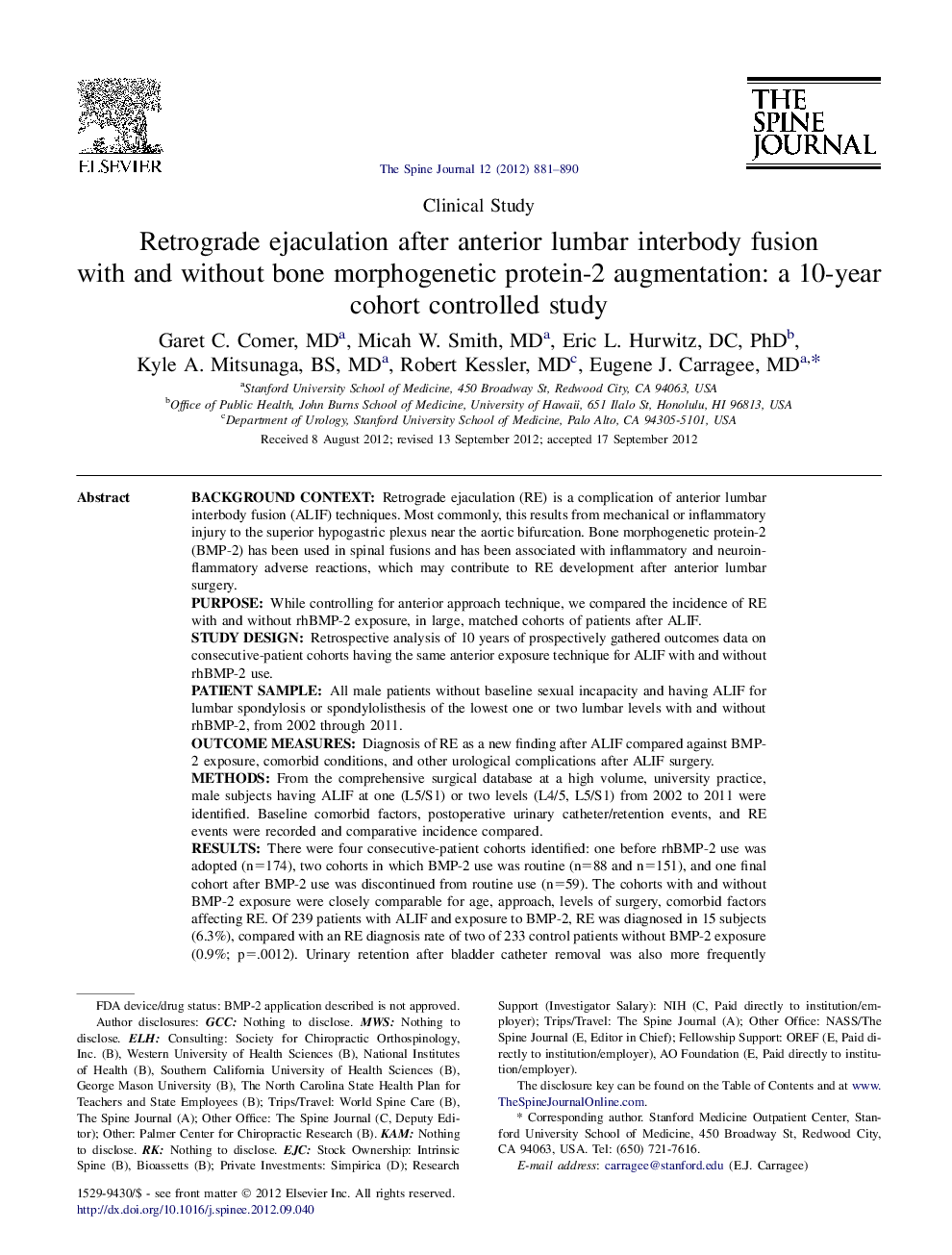| کد مقاله | کد نشریه | سال انتشار | مقاله انگلیسی | نسخه تمام متن |
|---|---|---|---|---|
| 4097414 | 1268590 | 2012 | 10 صفحه PDF | دانلود رایگان |

Background contextRetrograde ejaculation (RE) is a complication of anterior lumbar interbody fusion (ALIF) techniques. Most commonly, this results from mechanical or inflammatory injury to the superior hypogastric plexus near the aortic bifurcation. Bone morphogenetic protein-2 (BMP-2) has been used in spinal fusions and has been associated with inflammatory and neuroinflammatory adverse reactions, which may contribute to RE development after anterior lumbar surgery.PurposeWhile controlling for anterior approach technique, we compared the incidence of RE with and without rhBMP-2 exposure, in large, matched cohorts of patients after ALIF.Study designRetrospective analysis of 10 years of prospectively gathered outcomes data on consecutive-patient cohorts having the same anterior exposure technique for ALIF with and without rhBMP-2 use.Patient sampleAll male patients without baseline sexual incapacity and having ALIF for lumbar spondylosis or spondylolisthesis of the lowest one or two lumbar levels with and without rhBMP-2, from 2002 through 2011.Outcome measuresDiagnosis of RE as a new finding after ALIF compared against BMP-2 exposure, comorbid conditions, and other urological complications after ALIF surgery.MethodsFrom the comprehensive surgical database at a high volume, university practice, male subjects having ALIF at one (L5/S1) or two levels (L4/5, L5/S1) from 2002 to 2011 were identified. Baseline comorbid factors, postoperative urinary catheter/retention events, and RE events were recorded and comparative incidence compared.ResultsThere were four consecutive-patient cohorts identified: one before rhBMP-2 use was adopted (n=174), two cohorts in which BMP-2 use was routine (n=88 and n=151), and one final cohort after BMP-2 use was discontinued from routine use (n=59). The cohorts with and without BMP-2 exposure were closely comparable for age, approach, levels of surgery, comorbid factors affecting RE. Of 239 patients with ALIF and exposure to BMP-2, RE was diagnosed in 15 subjects (6.3%), compared with an RE diagnosis rate of two of 233 control patients without BMP-2 exposure (0.9%; p=.0012). Urinary retention after bladder catheter removal was also more frequently observed in patients exposed to BMP-2 (9.7%) compared with control patients (4.6%; p=.043). Of the baseline comorbid factors, medical or surgical treatment for prostatic hypertrophy disease was associated with an increased risk of RE in the BMP-2 patients (p=.034).ConclusionsThis study confirms previous reports of a higher rate of RE in ALIF procedures using rhBMP-2 and an open anterior approach to the spine. This effect may be associated with an increased risk of postoperative urinary retention after BMP-2 exposure. The magnitude of the RE effect may be increased with concomitant prostatic disease treatments.
Journal: The Spine Journal - Volume 12, Issue 10, October 2012, Pages 881–890